You may frequently hear the terms data science, machine learning (ML), and artificial intelligence (AI) used interchangeably, especially in this new generative AI revolution powered by technological innovations like OpenAI’s ChatGPT. There are significant distinctions even though these are all related.
The science of creating self-running software that can learn on its own or in tandem with other machines or people is known as machine learning (ML). Artificial intelligence, the science of giving machines the ability to make decisions like humans, is made possible in part by machine learning (ML).
Data science is the process of creating systems that collect and examine disparate data in order to find answers to real-world issues and different business challenges. The field of data science uses machine learning (ML) to automate data analysis and find patterns.
Both AI and machine learning (ML) are growing due to data science. You will learn more about data science vs machine learning vs AI in this article.
To avoid AI detection, use Undetectable AI. It can do it in a single click.
Table of Contents
How Does Data Science Relate to Artificial Intelligence, and What is It?
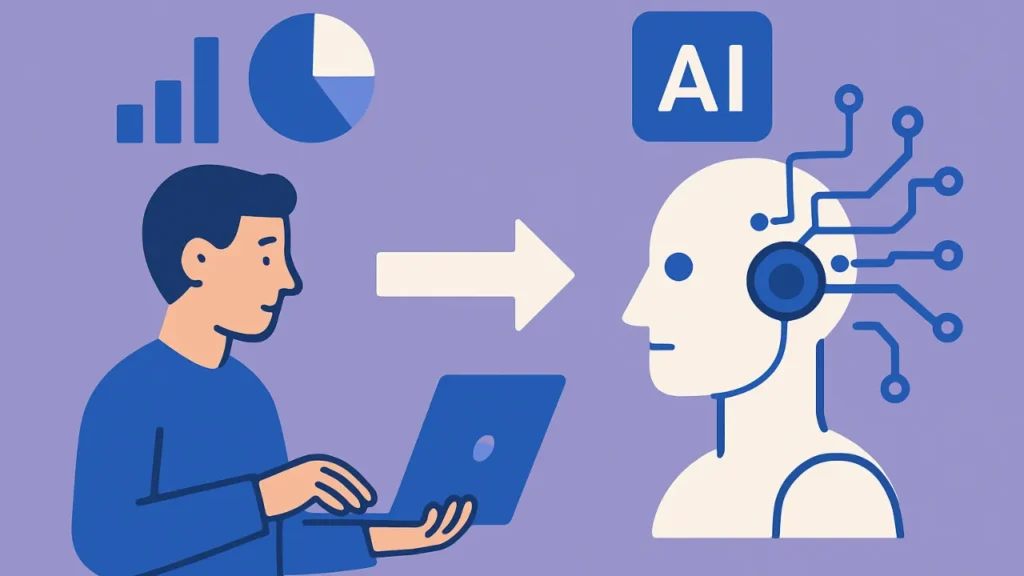
Artificial intelligence (AI) is a subfield of computer science that focuses on creating computers with flexible intelligence that can use data to solve complex problems, learn from those solutions, and make repeatable decisions at scale. However, there is disagreement over the definitions of data science and AI.
Big data collection and processing, adaptability to new inputs, and autonomous action based on analysis are all features of AI-enabled machines.
Personalized product and service recommendations on social media and online shopping platforms, AI-powered safety features in automobiles, genetic code analysis for medical condition detection, and more are just a few examples of the many everyday applications AI is used in.
The advancement of AI is facilitated by data scientists. In order for AI to build predictive models that produce insight from data, they develop algorithms that are intended to discover patterns and correlations in the data. AI is another tool that data scientists use to interpret data and guide business decisions.
How Does Machine Learning Relate to Data Science, and What is It?
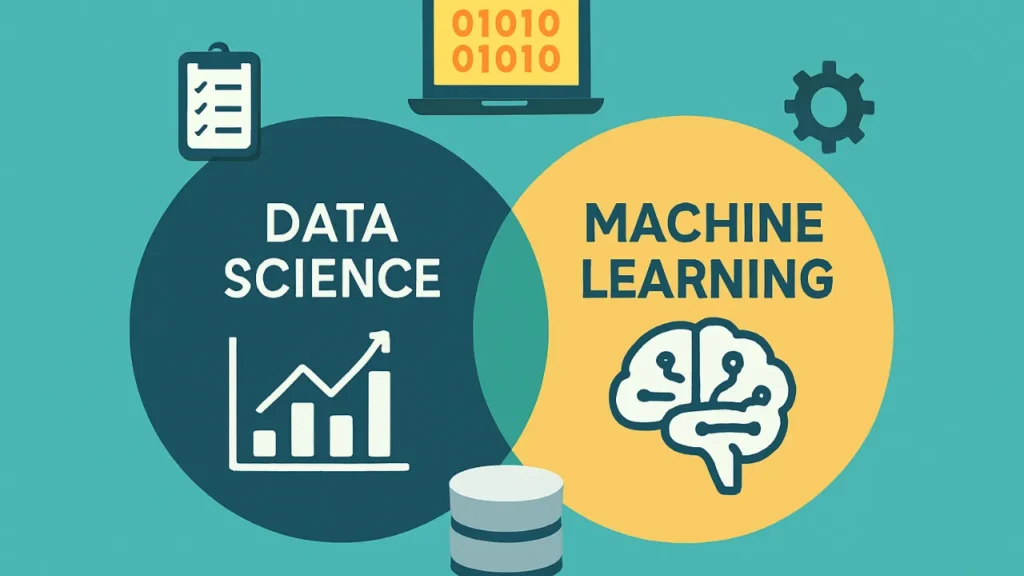
By allowing computers to learn how to behave and carry out human-like tasks using data, machine learning (ML)—a branch of artificial intelligence—makes AI possible.
Data scientists develop the algorithms that enable machine learning (ML), or the ability for machines to learn from data sources on their own without the need for software engineers or developers to write programs. This is how data science differs from machine learning (ML).
Machine learning (ML) is also used by data scientists as a tool or “amplifier” to extract meaning from data on a larger scale. In the modern world, machine learning (ML) is pervasive.
It’s what enables health systems to track and anticipate epidemics, smart home systems to automatically regulate indoor temperatures, and Netflix to suggest movies and videos.
How Do AI and Machine Learning Differ from One Another?
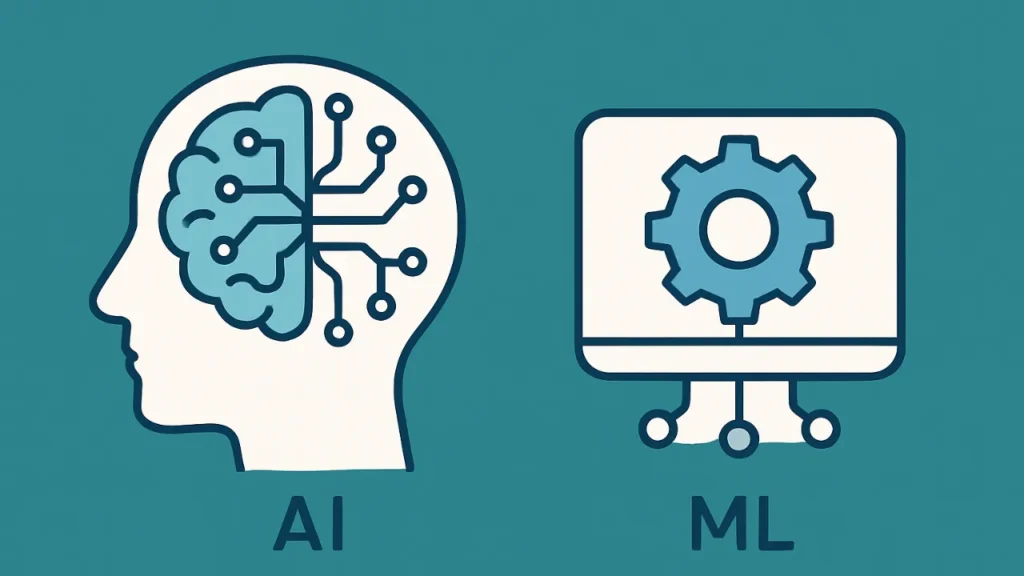
A subset of artificial intelligence (AI) is machine learning, to put it briefly. The objective of artificial intelligence is to enable machines to replicate and repeat human cognitive processes in order to solve complex problems and make decisions at scale.
One way to achieve artificial intelligence is through machine learning (ML), also known as “applied AI,” which focuses on how people can teach machines to learn from various data sources in order to solve challenging problems for us.
Put differently, machine learning (ML) is the process by which a computer can learn from data without explicit programming from a computer scientist, software engineer, or developer.
In addition to automating and scaling human intelligence, machine learning (ML) needs to be “explainable”—that is, transparently explained to a non-computer scientist or regular person—and closely watched to make sure it learns correct data in the proper way. If not, society may be faced with serious ethical AI problems.
How Machine Learning, AI, and Data Science Collaborate?
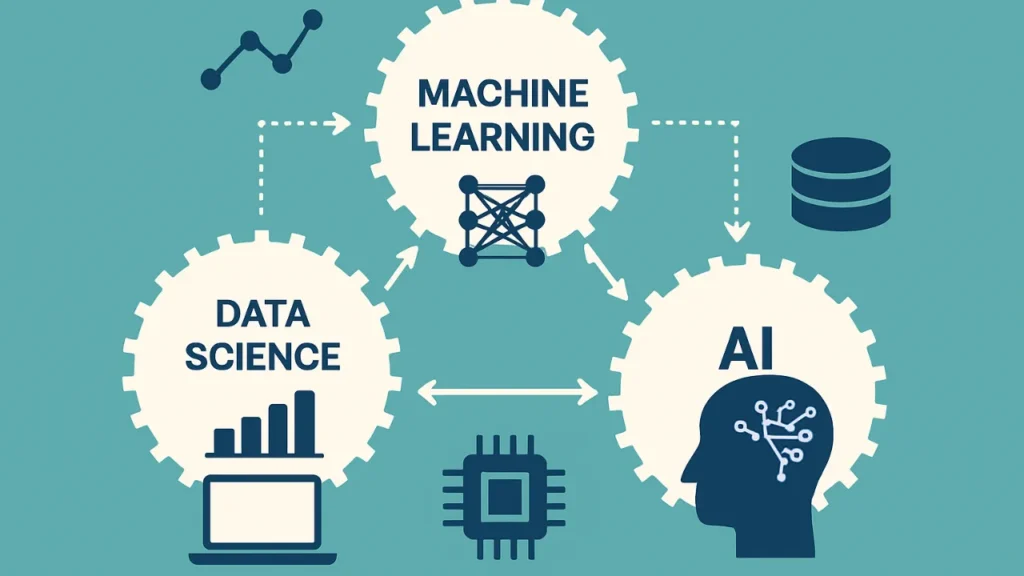
The intersections of AI, machine learning (ML), and data science must be taken into account. Data scientists are entrusted with “feeding” machines precise, empirical data and statistical models that allow machines to learn on their own. At their core, machines cannot hope to replicate human cognitive processes without information.
Society gets closer to achieving true artificial intelligence (AI) through continuous advancements in machine learning (ML). Data scientists can forecast behaviors, trends, and outcomes due to predictive analytics, which is made possible by machine learning (ML) and other subsets of artificial intelligence (such as deep learning).
Together, data scientists and machine learning (ML) algorithms can improve inventory control and delivery systems to help manufacturers and retailers provide better customer service.
Additionally, they enable voice recognition technology that controls smart TVs and conversational chatbot technology, which continuously improves healthcare support and customer service.
Medical care, financial guidance, and tailored product recommendations are made possible by machine learning. Best-in-class cybersecurity and fraud detection are also supported by the integration of data science, machine learning, and artificial intelligence.
Every day brings new innovations like ChatGPT and other advances in generative AI.
Comparison: Data Science Vs Machine Learning Vs AI
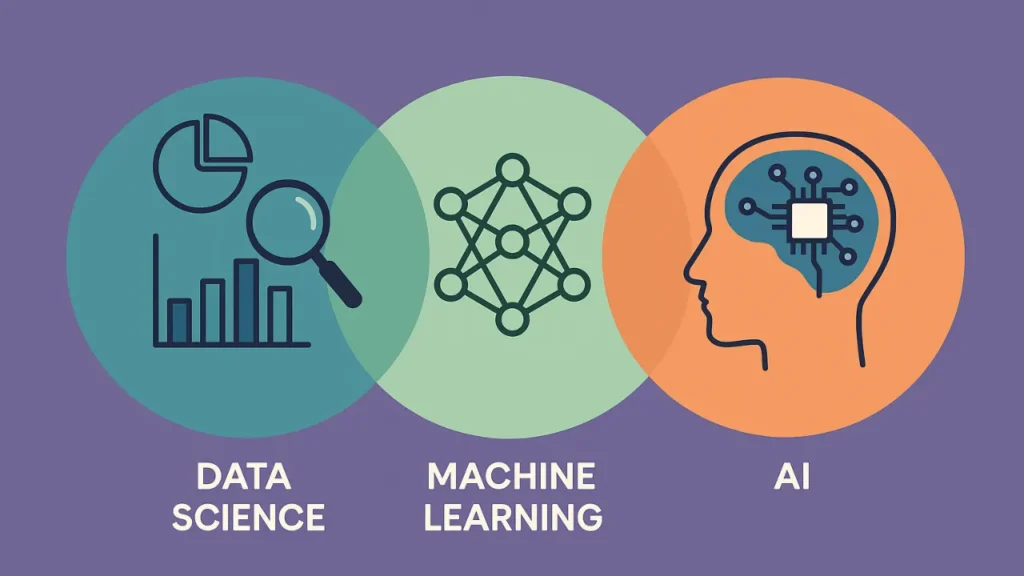
Data is the element that unites machine learning (ML), artificial intelligence, and data science. Big data management, processing, and interpretation are the main goals of data science in order to efficiently support decision-making.
Read Also >>> Best AI APIs for 2025
Algorithms are used in machine learning (ML) to evaluate data, draw conclusions from it, and predict trends. For artificial intelligence to learn and make better decisions, it needs a constant stream of data.
Here is a comparison between them:
| Data Science Vs Machine Learning Vs AI | |||
| Data Science | AI | Machine Learning | |
| Focus | Make sense of both structured and unstructured data to help with planning and decision-making. | Give computers the ability to carry out sophisticated cognitive functions that people do, such as perception, problem-solving, decision-making, and comprehending human communication. | Give systems a means of combining data, learning from it, and applying the knowledge gained to get better over time. |
| Application | Applying descriptive, predictive, and prescriptive analytics to business and problem-solving. Examples include process improvement, financial analysis, and customer trends. | Use learning, reasoning, and self-correction to accomplish tasks just like a human. Examples include voice assistants, chatbots, online gaming, and robots. | Make predictions and learn from structured and semi-structured data by extracting knowledge from them. Examples include search algorithms, health monitoring, and automated recommendations. |
| Skills required | Advanced mathStatisticsAnalytics and modelingDatabase managementData visualizationMachine learning methodsCommunication and collaborationProgramming for data science (particularly Python) | Advanced mathProbability and statisticsProgramming (particularly Python, R, Java, and C++)Spark and other big data technologies | Applied mathematicsNeural network architecturesPhysicsData modeling and evaluationAdvanced signal processing techniquesNatural language processingAudio and video processingReinforcement learning |
Various Job Titles Data Science Vs Machine Learning Vs AI
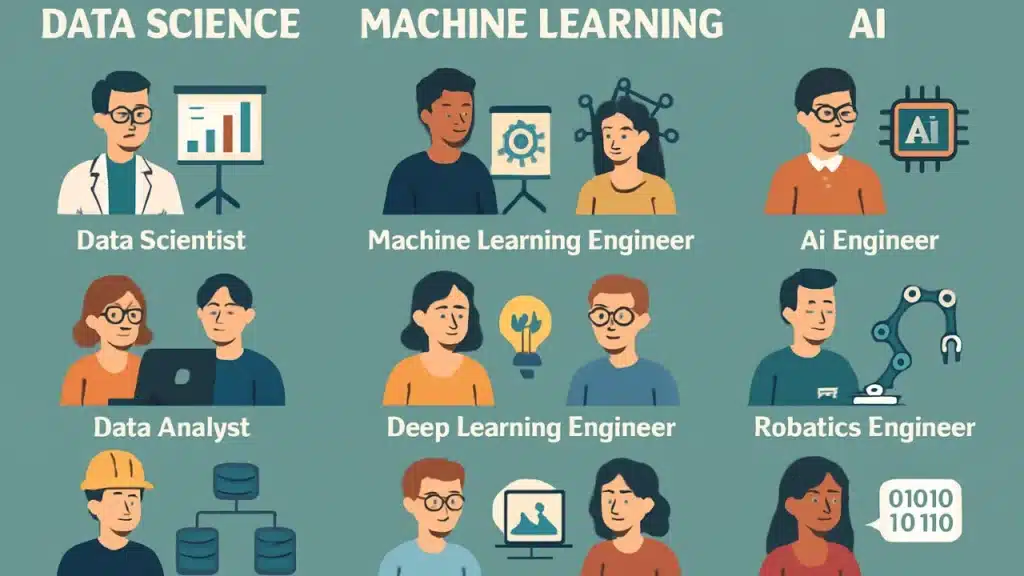
The goal of data scientists’ work is to glean insightful information from large datasets. Big data is gathered, cleaned, organized, analyzed, and visualized using computer programs. Additionally, they might write algorithms to query data for various objectives.
To create and manage scalable machine learning (ML) software models, machine learning engineers collaborate with data scientists. To create deployable versions of the machine learning (ML) models, data scientists and AI engineers collaborate closely.
Data scientist job titles:
- Data scientist
- Data engineer
- Data architect
- Chief data officer
Machine learning job titles:
- AI/ML engineering leader
- AI Sr. consultant
- AI/ML solutions architect
AI job titles:
- NLP data scientist
- Robotics engineer (computer vision)
- Bioinformatics scientist
- Sr. bioinformatics analyst
FAQs: Data Science Vs Machine Learning Vs AI
What is Data Science?
Data Science is an interdisciplinary field that uses scientific methods, processes, algorithms, and systems to extract knowledge and insights from structured and unstructured data.
What is Machine Learning?
Machine Learning is a subset of artificial intelligence that focuses on the development of algorithms that allow computers to learn from and make predictions or decisions based on data.
What is Artificial Intelligence?
Artificial Intelligence (AI) refers to the simulation of human intelligence in machines that are programmed to think and learn like humans, including problem-solving, understanding language, and recognizing patterns.
How do Data Science, Machine Learning, and AI differ?
Data Science encompasses the entire data analysis process, Machine Learning focuses on algorithm development for predictive modeling, and AI aims to create machines that can perform tasks typically requiring human intelligence.
Can Machine Learning exist without Data Science?
Machine Learning relies heavily on data, which is a fundamental aspect of Data Science. Therefore, while they can be discussed separately, Machine Learning cannot function effectively without the data analysis techniques provided by Data Science.
Is AI the same as Machine Learning?
No, AI is a broader concept that includes Machine Learning as one of its components. While all Machine Learning is AI, not all AI is Machine Learning.
Which field has better job prospects?
Both Data Science and Machine Learning offer strong job prospects, but the demand may vary based on industry needs. AI roles are also growing rapidly as technology advances.
What skills are needed for each field?
Data Science requires skills in statistics, data analysis, and data visualization. Machine Learning emphasizes programming, algorithm development, and statistical modeling, while AI focuses on understanding cognitive processes and advanced programming.
Conclusion: Data Science Vs Machine Learning Vs AI
In summary, data science, machine learning, and artificial intelligence are interconnected fields that play crucial roles in analyzing and interpreting data.
Data science serves as the foundation, encompassing the processes of collecting, cleaning, and analyzing data. Machine learning, a subset of data science, focuses on developing algorithms that enable computers to learn from and make predictions based on data.
Artificial intelligence, which includes machine learning, aims to create systems that can perform tasks that typically require human intelligence. Understanding the distinctions and relationships between these fields is essential for leveraging their potential in solving complex problems and driving innovation in various industries.


